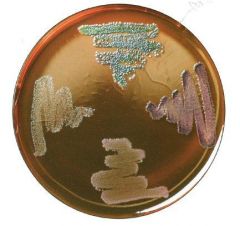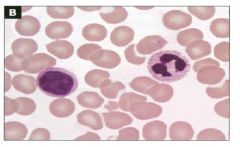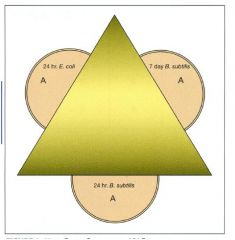![]()
![]()
![]()
Use LEFT and RIGHT arrow keys to navigate between flashcards;
Use UP and DOWN arrow keys to flip the card;
H to show hint;
A reads text to speech;
36 Cards in this Set
- Front
- Back

|
Mannitol Salt Agar
This MSA was inoculated with two of the organisms used in today's lab. Both grew well, but only the top one fermented mannitol and produced acid end products. This is evidenced by the yellow grow and halo surrounding it. Compare this plate with the one in Figure 4-3 and see if you can identify the organisms |
|

|
Mannitol Salt Agar Streaked for Isolation
This MSA was inoculated with the same two organisms as in Figure 4-2. The solid growth in the first three quadrants is still a mixture of the two organisms, so disregard the color in this region. Note the small red colonies and larger yellow colonies in the fourth streak. |
|

|
Mannitol Fermentation With Acid End Products
|
|

|
Eosin Methylene Blue Agar
This EMB Agar was inoculated with (clockwise from the top) two coliforms, a gram negative noncoliform, and a gram-positive organism. note the characteristic green metallic sheen of the coliform at the top and the pink coloration of the one at the right. Both organisms are lactose fermenters; the difference in color results from the degree of acid production. The organism on the botttom is a non fermenter, as indicated by the lack of color. Growth of the Grampositive organism on the left was inhibited by eosin Y and methylene blue |
|

|
Eosin Methylene Blue Agar Streaked For Isolation
This EMB agar was inoculated with two of the Gram-negative rods shown in Figure 4-7. One is a coliform; the other is not. Color produced by mixtures of bacteria is not determinative, so disregard the first three quadrants and pay attention only to the individual colonies. the coliform that produced a green metallic sheen on the plate shown in Figure 4-7 produced pink colonies with dark centers in this photo. The noncoliform colonies are beige |
|

|
Lactose Fermentation with Acid End Products
|
|

|
MacConkey Agar Streaked for Isolation
This MacConkey Agar was inoculated with two enteric organisms similar to those selected for today's excercise. Both grew well, but only one fermented the lactose. The solid growth in the first three quadrants is a mixture of the two organisms, so the color produced in that region is not determinative. Note the colors of the individiual colonies |
|

|
MacConkey Agar
This MacConkey Agar was inoculated with four members of Enterobacteriaceae, all of which show abundant growth. The top organism and the one on the right are lactose fermenters, as evidenced by the pink color. Note the bile precipitate around the top organism. The organisms on the bottom and on the left produced no color, so they do not appear to be lactorse fermenters. |
|

|
B-Hemolysis
Streptococcus pyogenes demonstrates B-hemolysis. The clearing around the growth is a result of complete lysis of red blood cells. This photograph was taken with transmitted light. |
|

|
A-hemolysis
This is a streak plate of Streptococcus pneumoniae demonstrating A-hemolysis. The greenish zone around the colonies results from incomplete lysis of red blood cells. |
|

|
Disk Diffusion Test of Methicillin-Resistant Staphylococcus Aureus (MRSA)
|
|

|
McFarland Standards
This is a comparison of a McFarland Turbidity standard to three broths with varying degrees of turbidity. |
|

|
Disk Dispenser
This antibiotic disk dispenser is used to uniformly deposit disks on a Mueller-Hinton agar plate |
|

|
Measuring the Antimicrobial Susceptibility Zones
Using a metric ruler, measure the diameter of each clearing. Standards for comparison are given in millimeters. |
|

|
Procedural Diagram for Chemical Germicides
|
|

|
Type A
|
|

|
Type B
|
|

|
Type AB
|
|

|
Type O
|
|

|
Neutrophil
The Segmented nucleus of this cell indentifies it was a mature neutrophil (seg). About 30% of neutrophils in blood samples from females demonstrate a "drumstick" protruding from the nucleus, as in this speciment. This is the region of the inactive X chromosome. |
|

|
Neutrophil
This is an immature band neutrophil with an unsegmented nucleus. Both specimens were prepared with Wright's stain and were magnifiedX1000 |
|

|
Eosinophil
These granulocytes are relatively rare and are about twice the size of red blood cells. Their cytoplasmic granules stain red, and their nucleus usually has two lobes. This specimen was prepared with Wright's stain and was magnifiedX1000 |
|

|
Basophil
Basophils comprise only about 1% of all white blood cells. They are slightly larger than red blood cells and have dark purple cytoplasmic granules that obscure the nucleus. This micrograph was prepared with Wright's stain and magnified X1000 |
|

|
Monocyte
Monocytes are the blood form of macrophages. They are about twice the size of red blood cells and have a round or indented nucleus. Wright's stain, X1000, was used |
|

|
Lymphocyte
|
|

|
These are natural killer (NK) cells or some other type of null cell. Also visible is a neutrophil. All micrographs are x1000
|
|

|
Following a Systematic Path
A systematic scanning path is used to avoid wandering around the slide and perhaps counting some cells more than once. Remember that a microscope image is inverted. If you want the image to move left, you must move the slide to the right. |
|

|
Electromagnetic Spectrum
The shortest and highest energy wavelengths are those of gamma rays, starting at about at 10^-5 nm. Radio waves, at the other end of the spectrum, can be one kilometer or longer. Between about 100nm and 380 nm (just below visible light) is the sliver known as ultraviolet light. |
|

|
Plates Shielded for UV Exposure
Place the three plates under the UV lamp with the covers removed and the cardboard shield covering half of each plate, as shown. Make sure the Petri dish covers are placed open side down on a disinfectant soaked towel. |
|

|
A Thymine Dimer in One Strand of DNA
Thymine dimers form when DNA absorbs UV radiation with a wavelength of 254 nm. The energy is used to form two new covalent bond between the thymines, resulting in distortion of the DNA strand. The enzyme DNA photolyase can break this bond to return the DNA to its normal shape and function. If it doesn't, the distortion interferes with DNA replication and transcription. |
|

|
DNA ligase to form a covalent bond between the new and the original strands. In reality, the segment excised is 13 nucleotides long.
|
|

|
An endonuclease to break two covalent bonds in the sugar-phosphate back bone of the damaged stand
|
|

|
A helicase to remove the nucleotides in the damaged segment
|
|

|
DNA polymerase I to synthesize a new strand
|
|

|
This is an example of a mask placed over a petridish. The cutout may be any shape but should leave the outer 25% of the plate masked
|
|

|
Procedural Diagram for Ultraviolet Radiation Damage and Repair
|

